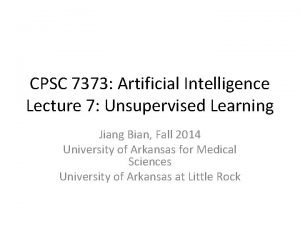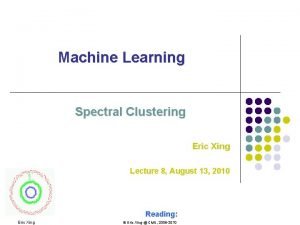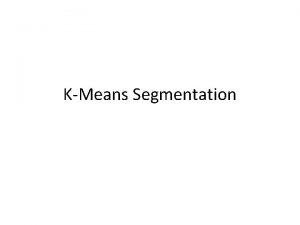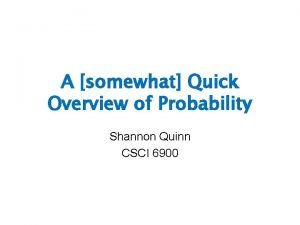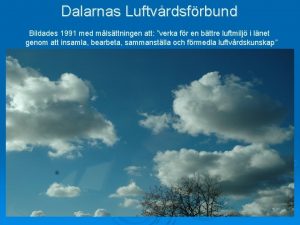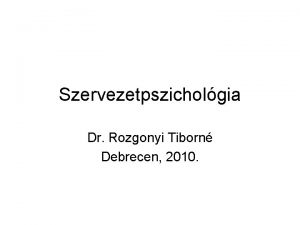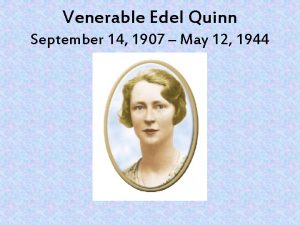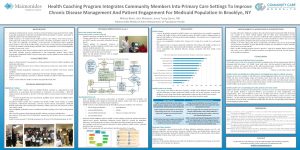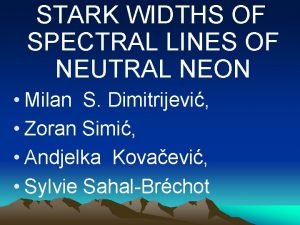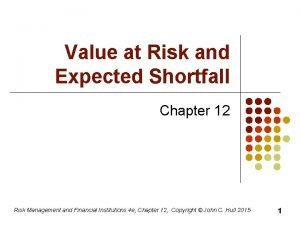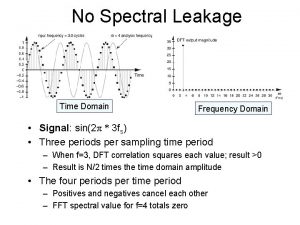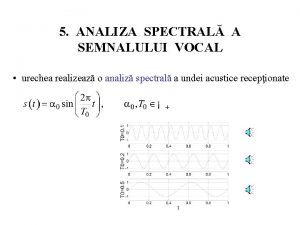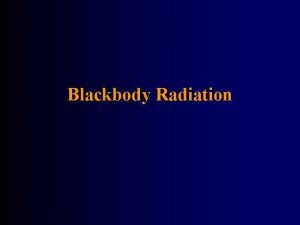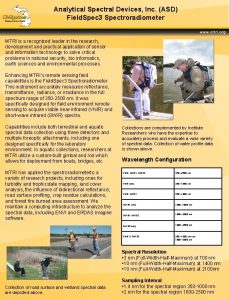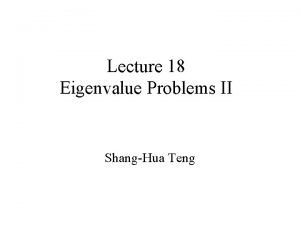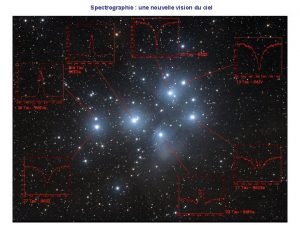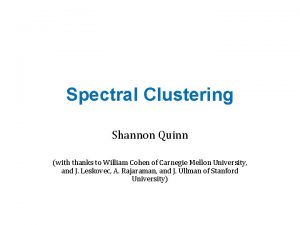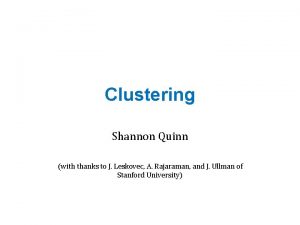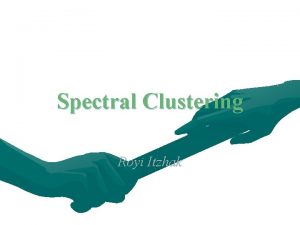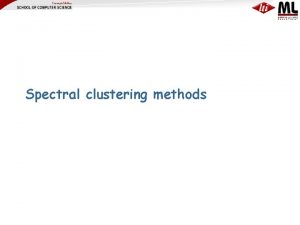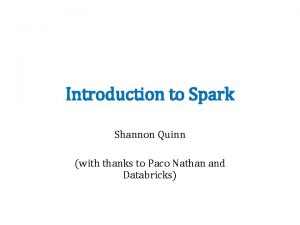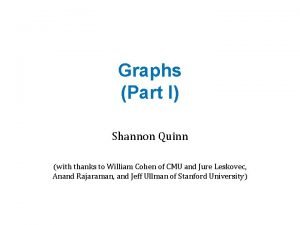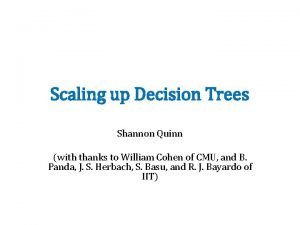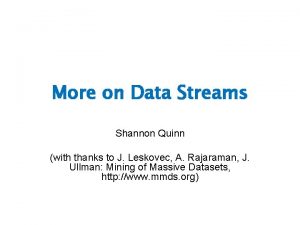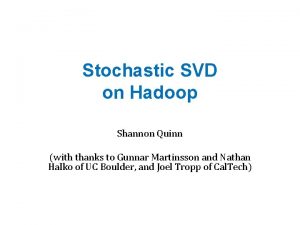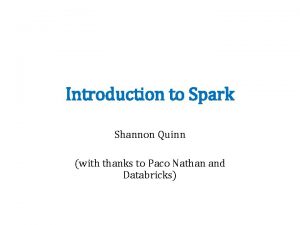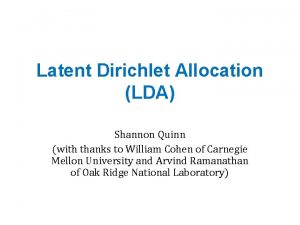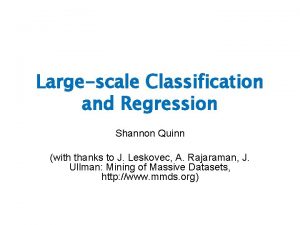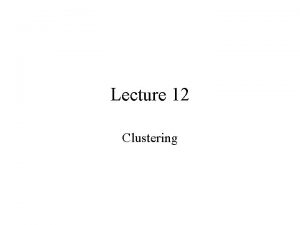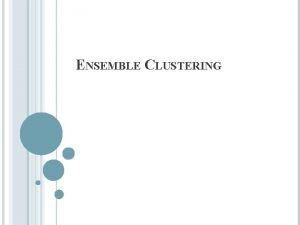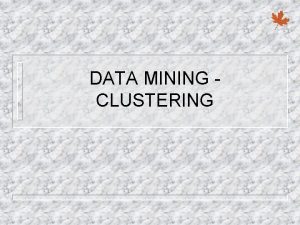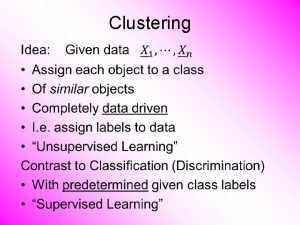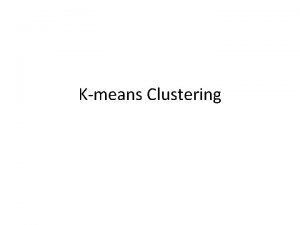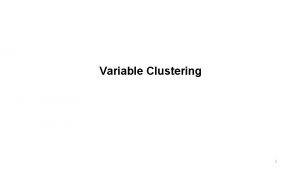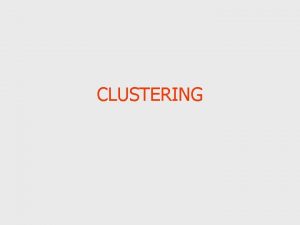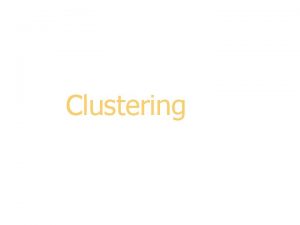Spectral Clustering Shannon Quinn with thanks to William





![[Shi-Malik] Graph Cut Criteria • J. Leskovec, A. Rajaraman, J. Ullman: Mining of Massive [Shi-Malik] Graph Cut Criteria • J. Leskovec, A. Rajaraman, J. Ullman: Mining of Massive](https://slidetodoc.com/presentation_image_h/30c4c9376b114bc3e62bebdc00f00849/image-6.jpg)


![Matrix Representations • Adjacency matrix (A): – n n matrix – A=[aij], aij=1 if Matrix Representations • Adjacency matrix (A): – n n matrix – A=[aij], aij=1 if](https://slidetodoc.com/presentation_image_h/30c4c9376b114bc3e62bebdc00f00849/image-9.jpg)
![Matrix Representations • Degree matrix (D): – n n diagonal matrix – D=[dii], dii Matrix Representations • Degree matrix (D): – n n diagonal matrix – D=[dii], dii](https://slidetodoc.com/presentation_image_h/30c4c9376b114bc3e62bebdc00f00849/image-10.jpg)










![Why use multiple eigenvectors? • Approximates the optimal cut [Shi-Malik, ’ 00] – Can Why use multiple eigenvectors? • Approximates the optimal cut [Shi-Malik, ’ 00] – Can](https://slidetodoc.com/presentation_image_h/30c4c9376b114bc3e62bebdc00f00849/image-21.jpg)












- Slides: 33

Spectral Clustering Shannon Quinn (with thanks to William Cohen of Carnegie Mellon University, and J. Leskovec, A. Rajaraman, and J. Ullman of Stanford University)

Graph Partitioning • 5 1 2 4 3 A 2 3 B 5 1 4 J. Leskovec, A. Rajaraman, J. Ullman: Mining of Massive Datasets, 6 6 2

Graph Partitioning • What makes a good partition? – Maximize the number of within-group connections – Minimize the number of between-group connections 5 1 2 3 A 6 4 B J. Leskovec, A. Rajaraman, J. Ullman: Mining of Massive Datasets, 3

Graph Cuts • Express partitioning objectives as a function of the “edge cut” of the partition • Cut: Set of edges with only one vertex in a group: A 1 2 3 B 5 4 6 J. Leskovec, A. Rajaraman, J. Ullman: Mining of Massive Datasets, cut(A, B) = 2 4

Graph Cut Criterion • Criterion: Minimum-cut – Minimize weight of connections between groups arg min. A, B cut(A, B) • Degenerate case: “Optimal cut” Minimum cut • Problem: – Only considers external cluster connections – Does not consider internal cluster connectivity J. Leskovec, A. Rajaraman, J. Ullman: Mining of Massive Datasets, 5
![ShiMalik Graph Cut Criteria J Leskovec A Rajaraman J Ullman Mining of Massive [Shi-Malik] Graph Cut Criteria • J. Leskovec, A. Rajaraman, J. Ullman: Mining of Massive](https://slidetodoc.com/presentation_image_h/30c4c9376b114bc3e62bebdc00f00849/image-6.jpg)
[Shi-Malik] Graph Cut Criteria • J. Leskovec, A. Rajaraman, J. Ullman: Mining of Massive Datasets, 6

Spectral Graph Partitioning • J. Leskovec, A. Rajaraman, J. Ullman: Mining of Massive Datasets, 7

What is the meaning of Ax? • J. Leskovec, A. Rajaraman, J. Ullman: Mining of Massive Datasets, 8
![Matrix Representations Adjacency matrix A n n matrix Aaij aij1 if Matrix Representations • Adjacency matrix (A): – n n matrix – A=[aij], aij=1 if](https://slidetodoc.com/presentation_image_h/30c4c9376b114bc3e62bebdc00f00849/image-9.jpg)
Matrix Representations • Adjacency matrix (A): – n n matrix – A=[aij], aij=1 if edge between node i and j 1 2 3 4 5 6 1 0 1 0 2 1 0 0 0 3 1 1 0 0 4 0 0 1 1 5 1 0 0 1 • Important properties: 6 0 0 0 1 – Symmetric matrix – Eigenvectors are real and orthogonal 0 1 1 0 5 1 2 3 4 6 J. Leskovec, A. Rajaraman, J. Ullman: Mining of Massive Datasets, 9
![Matrix Representations Degree matrix D n n diagonal matrix Ddii dii Matrix Representations • Degree matrix (D): – n n diagonal matrix – D=[dii], dii](https://slidetodoc.com/presentation_image_h/30c4c9376b114bc3e62bebdc00f00849/image-10.jpg)
Matrix Representations • Degree matrix (D): – n n diagonal matrix – D=[dii], dii = degree of node i 5 1 2 3 4 6 1 2 3 4 5 6 1 3 0 0 0 2 0 0 3 0 0 0 4 0 0 0 3 0 0 5 0 0 3 0 6 0 0 0 2 J. Leskovec, A. Rajaraman, J. Ullman: Mining of Massive Datasets, 10

Matrix Representations • Laplacian matrix (L): – n n symmetric matrix 5 1 2 3 4 6 1 2 3 4 5 6 1 3 -1 -1 0 2 -1 0 0 0 3 -1 -1 3 -1 0 0 4 0 0 -1 3 -1 -1 5 -1 0 0 -1 3 -1 6 0 0 0 -1 -1 2 • What is trivial eigenpair? • Important properties: – Eigenvalues are non-negative real numbers – Eigenvectors are real and orthogonal J. Leskovec, A. Rajaraman, J. Ullman: Mining of Massive Datasets, 11

Spectral Clustering: Graph = Matrix W*v 1 = v 2 “propogates weights from neighbors” e 2 0. 4 0. 2 xxxxxx xxx 0. 0 -0. 2 yyyy zzzzzz zz zz e 1 y -0. 4 -0. 2 0 [Shi & Meila, 2002] 0. 2 e 3 e 2

Spectral Clustering: Graph = Matrix W*v 1 = v 2 “propagates weights from neighbors” If Wis connected but roughly block diagonal with k blocks then • the top eigenvector is a constant vector • the next k eigenvectors are roughly piecewise constant with “pieces” corresponding to blocks M

Spectral Clustering: Graph = Matrix W*v 1 = v 2 “propagates weights from neighbors” If W is connected but roughly block diagonal with k blocks then • the “top” eigenvector is a constant vector • the next k eigenvectors are roughly piecewise constant with “pieces” corresponding to blocks M Spectral clustering: • Find the top k+1 eigenvectors v 1, …, vk+1 • Discard the “top” one • Replace every node a with k-dimensional vector xa = <v 2(a), …, vk+1 (a) > • Cluster with k-means

So far… • How to define a “good” partition of a graph? – Minimize a given graph cut criterion • How to efficiently identify such a partition? – Approximate using information provided by the eigenvalues and eigenvectors of a graph • Spectral Clustering J. Leskovec, A. Rajaraman, J. Ullman: Mining of Massive Datasets, 15

Spectral Clustering Algorithms • Three basic stages: – 1) Pre-processing • Construct a matrix representation of the graph – 2) Decomposition • Compute eigenvalues and eigenvectors of the matrix • Map each point to a lower-dimensional representation based on one or more eigenvectors – 3) Grouping • Assign points to one (or more) clusters, based on the new representation J. Leskovec, A. Rajaraman, J. Ullman: Mining of Massive Datasets, 16

Value of x 2 Example: Spectral Partitioning Rank in x 2 J. Leskovec, A. Rajaraman, J. Ullman: Mining of Massive Datasets, http: //www. mmds. org 17

Example: Spectral Partitioning Value of x 2 Components of x 2 J. Leskovec, A. Rajaraman, J. Ullman: Mining of Massive Datasets, http: //www. mmds. org Rank in x 2 18

Example: Spectral partitioning Components of x 1 J. Leskovec, A. Rajaraman, J. Ullman: Components of x 3 Mining of Massive Datasets, http: //www. mmds. org 19

k-Way Spectral Clustering • How do we partition a graph into k clusters? • Two basic approaches: – Recursive bi-partitioning [Hagen et al. , ’ 92] • Recursively apply bi-partitioning algorithm in a hierarchical divisive manner • Disadvantages: Inefficient, unstable – Cluster multiple eigenvectors [Shi-Malik, ’ 00] • Build a reduced space from multiple eigenvectors • Commonly used in recent papers • A preferable approach… J. Leskovec, A. Rajaraman, J. Ullman: Mining of Massive Datasets, 20
![Why use multiple eigenvectors Approximates the optimal cut ShiMalik 00 Can Why use multiple eigenvectors? • Approximates the optimal cut [Shi-Malik, ’ 00] – Can](https://slidetodoc.com/presentation_image_h/30c4c9376b114bc3e62bebdc00f00849/image-21.jpg)
Why use multiple eigenvectors? • Approximates the optimal cut [Shi-Malik, ’ 00] – Can be used to approximate optimal k-way normalized cut • Emphasizes cohesive clusters – Increases the unevenness in the distribution of the data – Associations between similar points are amplified, associations between dissimilar points are attenuated – The data begins to “approximate a clustering” • Well-separated space – Transforms data to a new “embedded space”, consisting of k orthogonal basis vectors • Multiple eigenvectors prevent instability due to information loss J. Leskovec, A. Rajaraman, J. Ullman: Mining of Massive Datasets, 21

Spectral Clustering: Graph = Matrix W*v 1 = v 2 “propogates weights from neighbors” • smallest eigenvecs of D-A are largest eigenvecs of A • smallest eigenvecs of I-W are largest eigenvecs of W Q: How do I pick v to be an eigenvector for a blockstochastic matrix?

Spectral Clustering: Graph = Matrix W*v 1 = v 2 “propogates weights from neighbors” How do I pick v to be an eigenvector for a blockstochastic matrix?

Spectral Clustering: Graph = Matrix W*v 1 = v 2 “propogates weights from neighbors” • smallest eigenvecs of D-A are largest eigenvecs of A • smallest eigenvecs of I-W are largest eigenvecs of W Suppose each y(i)=+1 or -1: • Then y is a cluster indicator that cuts the nodes into two • what is y. T(D-A)y ? The cost of the graph cut defined by y • what is y. T(I-W)y ? Also a cost of a graph cut defined by y • How to minimize it? • Turns out: to minimize y. T X y / (y. Ty) find smallest eigenvector of X • But: this will not be +1/-1, so it’s a “relaxed” solution

Spectral Clustering: Graph = Matrix W*v 1 = v 2 “propogates weights from neighbors” λ 1 e 1 λ 2 e 3 λ 3 “eigengap” λ 4 e 2 λ 5, 6, 7, …. [Shi & Meila, 2002]

Some more terms • If A is an adjacency matrix (maybe weighted) and D is a (diagonal) matrix giving the degree of each node – Then D-A is the (unnormalized) Laplacian – W=AD-1 is a probabilistic adjacency matrix – I-W is the (normalized or random-walk) Laplacian – etc…. • The largest eigenvectors of W correspond to the smallest eigenvectors of I-W – So sometimes people talk about “bottom eigenvectors of the Laplacian”

A W K-nn graph (easy) Fully connected graph, weighted by distance



Spectral Clustering: Pros and Cons • Elegant, and well-founded mathematically • Works quite well when relations are approximately transitive (like similarity) • Very noisy datasets cause problems – “Informative” eigenvectors need not be in top few – Performance can drop suddenly from good to terrible • Expensive for very large datasets – Computing eigenvectors is the bottleneck

Use cases and runtimes • K-Means – FAST – “Embarrassingly parallel” – Not very useful on anisotropic data • Spectral clustering – Excellent quality under many different data forms – Much slower than KMeans

Further Reading • Spectral Clustering Tutorial: http: //www. informatik. unihamburg. de/ML/contents/people/luxburg/pu blications/Luxburg 07_tutorial. pdf

How is Assignment 3 going?
 Spectral clustering
Spectral clustering Eric xing
Eric xing Spectral clustering
Spectral clustering Rumus distance
Rumus distance Flat clustering vs hierarchical clustering
Flat clustering vs hierarchical clustering Partitional clustering vs hierarchical clustering
Partitional clustering vs hierarchical clustering Ashlyn quinn
Ashlyn quinn Quinn prob
Quinn prob Self – marc quinn, 1991
Self – marc quinn, 1991 Marc quinn self 1991
Marc quinn self 1991 Paulyn marrinan quinn
Paulyn marrinan quinn Versengő értékek modell
Versengő értékek modell Edel quinn
Edel quinn Jim quinn net worth
Jim quinn net worth O mary conceived without sin
O mary conceived without sin Greg quinn caredx
Greg quinn caredx Duane quinn
Duane quinn Cuestionario ocai
Cuestionario ocai Richard quinn ucf cheating
Richard quinn ucf cheating Penny quinn
Penny quinn Dr john quinn beaumont
Dr john quinn beaumont Jenny tsang-quinn
Jenny tsang-quinn Feargal quinn
Feargal quinn Hornby cdu
Hornby cdu Strongback bridging
Strongback bridging Neon spectral lines
Neon spectral lines Value at risk formula
Value at risk formula Spectral leakage
Spectral leakage Spectral unmixing
Spectral unmixing Spectral class
Spectral class Spectral pitch display adobe audition
Spectral pitch display adobe audition Analytical spectral devices
Analytical spectral devices Linear algebra spectral theorem
Linear algebra spectral theorem Profil spectral de rigel
Profil spectral de rigel
